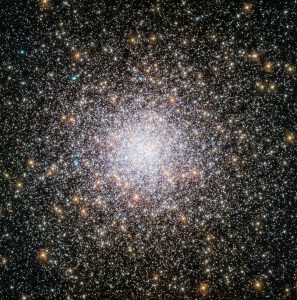La Giovinezza di NGC 362
Gli ammassi globulari offrono una delle visioni più spettacolari nel cielo notturno. Queste sfere adorne di astri contengono centinaia di migliaia di stelle, e risiedono nelle periferie delle galassie. La Via Lattea ne contiene più di 150 e quello mostrato in questa nuova immagine del telescopio Hubble, chiamato NGC 362, è uno dei più inusuali.
Nel corso della loro esistenza le stelle fondono elementi nel nucleo, creando durante questo processo elementi sempre più pesanti, conosciuti in astronomia come metalli. Quando muoiono diffondono nell’ambiente circostante i materiali che hanno formato durante la loro vita, arricchendo di metalli il mezzo interstellare. Le stelle che si formano in seguito contengono percentuali di metalli più elevate rispetto a quelle più vecchie.
Studiando i diversi elementi presenti all’interno delle singole stelle in NGC 362, gli astronomi hanno scoperto che l’ammasso vanta un contenuto di metalli sorprendentemente alto, ad indicare che è più giovane del previsto. Sebbene la maggior parte degli ammassi globulari siano molto più vecchi della maggioranza delle stelle nella loro galassia, NGC 362 va contro la tendenza, nonostante la considerevole età stimata tra 10 e 11 miliardi di anni.
[ Barbara Bubbi ]
http://spacetelescope.org/images/potw1643a/
Credit:ESA/Hubble & NASA

Lascia un commento